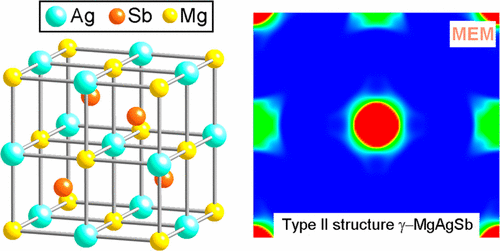当前位置:
X-MOL 学术
›
Chem. Mater.
›
论文详情
Our official English website, www.x-mol.net, welcomes your
feedback! (Note: you will need to create a separate account there.)
Elaborating the Crystal Structures of MgAgSb Thermoelectric Compound: Polymorphs and Atomic Disorders
Chemistry of Materials ( IF 7.2 ) Pub Date : 2017-07-19 00:00:00 , DOI: 10.1021/acs.chemmater.7b01768 Jian-Li Mi 1 , Ping-Jun Ying 2 , Mattia Sist 3 , Hazel Reardon 3 , Peng Zhang 1 , Tie-Jun Zhu 2 , Xin-Bing Zhao 2 , Bo Brummerstedt Iversen 3
Chemistry of Materials ( IF 7.2 ) Pub Date : 2017-07-19 00:00:00 , DOI: 10.1021/acs.chemmater.7b01768 Jian-Li Mi 1 , Ping-Jun Ying 2 , Mattia Sist 3 , Hazel Reardon 3 , Peng Zhang 1 , Tie-Jun Zhu 2 , Xin-Bing Zhao 2 , Bo Brummerstedt Iversen 3
Affiliation

|
Gaining insight into crystal structure is essential for understanding thermoelectric transport mechanisms and predicting thermoelectric properties. The main challenge in studying thermoelectric mechanisms is often imprecise or wrong models of the crystal structure. This work examines the structure modifications observed in MgAgSb thermoelectric materials by multitemperature high-resolution synchrotron radiation powder X-ray diffraction (SR-PXRD). Rietveld refinement reveals large atomic displacement parameters (ADPs) of the Ag1 atoms at the 4a position indicating possible atomic disorder, which may contribute to the low thermal conductivity observed in α-MgAgSb. The temperature dependence of anisotropic structural parameters indicates a tendency of increasing structural symmetry in α-MgAgSb with increasing temperature, largely contributing to the temperature evolution of the thermoelectric properties. Two MgAgSb polymorphs (β-MgAgSb and γ-MgAgSb) coexist at 700 K, and only the γ-MgAgSb crystalline phase is found at high temperatures (800–1000 K). The content of γ-MgAgSb phase decreases with temperature due to the increase of liquid impurities, and the sample is only 43.8% crystalline at 1000 K. At 800 K, the high resolution powder data are fitted equally well using type I (with Mg, Ag, and Sb on the 4b, 4c, and 4a sites, respectively) and type II (with Mg, Ag, and Sb on the 4a, 4b, and 4c sites, respectively) half-Heusler crystal structure models. Nonetheless, maximum entropy method (MEM) analysis carried out on the extracted factors shows that the type II structure gives a more physically sound MEM electron density. The disorder in γ-MgAgSb consists of mixed sites of Mg and Ag as well as vacancies, and the strong disorder of the cation sublattice contributes to the low thermal conductivity.
中文翻译:

阐述MgAgSb热电化合物的晶体结构:多晶型和原子序
深入了解晶体结构对于理解热电传输机理和预测热电特性至关重要。研究热电机理的主要挑战通常是晶体结构的不精确或错误模型。这项工作检查了MgAgSb热电材料中通过多温度高分辨率同步加速器辐射粉末X射线衍射(SR-PXRD)观察到的结构修饰。Rietveld精炼显示在a位置4a处Ag1原子的大原子位移参数(ADP)表明可能的原子无序,这可能导致在α-MgAgSb中观察到的低导热性。各向异性结构参数的温度依赖性表明α中结构对称性增加的趋势-MgAgSb随着温度的升高,在很大程度上促进了热电性能的温度演变。700 K下共存在两种MgAgSb多晶型物(β-MgAgSb和γ-MgAgSb),而在高温(800-1000 K)下仅发现γ-MgAgSb晶相。γ-MgAgSb相的含量由于液态杂质的增加而随温度降低而降低,在1000 K时样品仅结晶43.8%。在800 K时,使用I型(Mg, Ag和Sb的上4 b,4 c ^和4一个位点,分别地)和在4型II(用Mg,Ag和Sb的一个,4 b和4 c ^站点)半赫斯勒晶体结构模型。尽管如此,对提取的因子进行的最大熵方法(MEM)分析表明,II型结构给出了更合理的MEM电子密度。γ-MgAgSb中的无序由Mg和Ag的混合位点以及空位组成,阳离子亚晶格的强无序性导致了低热导率。
更新日期:2017-07-20
中文翻译:

阐述MgAgSb热电化合物的晶体结构:多晶型和原子序
深入了解晶体结构对于理解热电传输机理和预测热电特性至关重要。研究热电机理的主要挑战通常是晶体结构的不精确或错误模型。这项工作检查了MgAgSb热电材料中通过多温度高分辨率同步加速器辐射粉末X射线衍射(SR-PXRD)观察到的结构修饰。Rietveld精炼显示在a位置4a处Ag1原子的大原子位移参数(ADP)表明可能的原子无序,这可能导致在α-MgAgSb中观察到的低导热性。各向异性结构参数的温度依赖性表明α中结构对称性增加的趋势-MgAgSb随着温度的升高,在很大程度上促进了热电性能的温度演变。700 K下共存在两种MgAgSb多晶型物(β-MgAgSb和γ-MgAgSb),而在高温(800-1000 K)下仅发现γ-MgAgSb晶相。γ-MgAgSb相的含量由于液态杂质的增加而随温度降低而降低,在1000 K时样品仅结晶43.8%。在800 K时,使用I型(Mg, Ag和Sb的上4 b,4 c ^和4一个位点,分别地)和在4型II(用Mg,Ag和Sb的一个,4 b和4 c ^站点)半赫斯勒晶体结构模型。尽管如此,对提取的因子进行的最大熵方法(MEM)分析表明,II型结构给出了更合理的MEM电子密度。γ-MgAgSb中的无序由Mg和Ag的混合位点以及空位组成,阳离子亚晶格的强无序性导致了低热导率。
















































 京公网安备 11010802027423号
京公网安备 11010802027423号